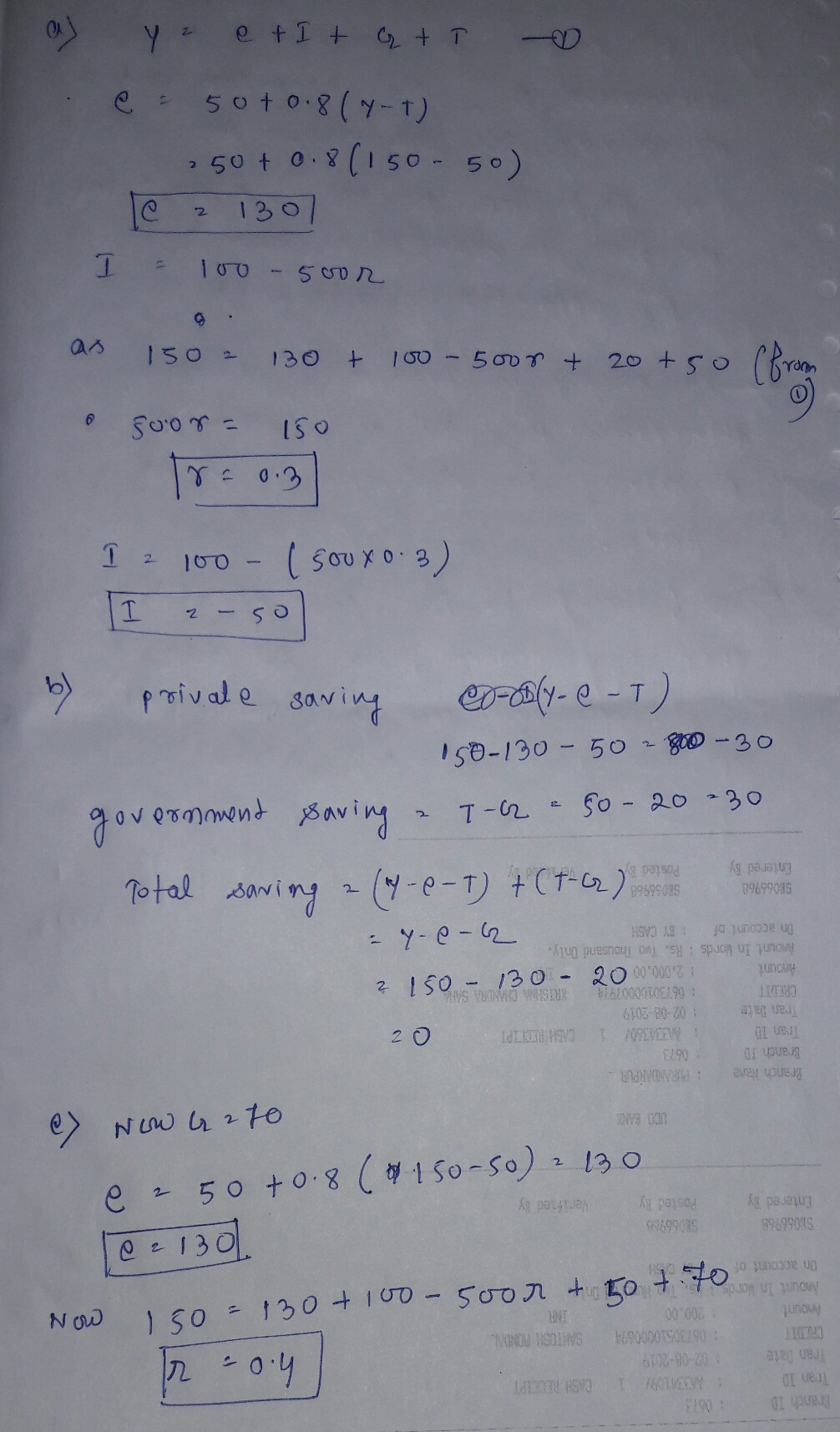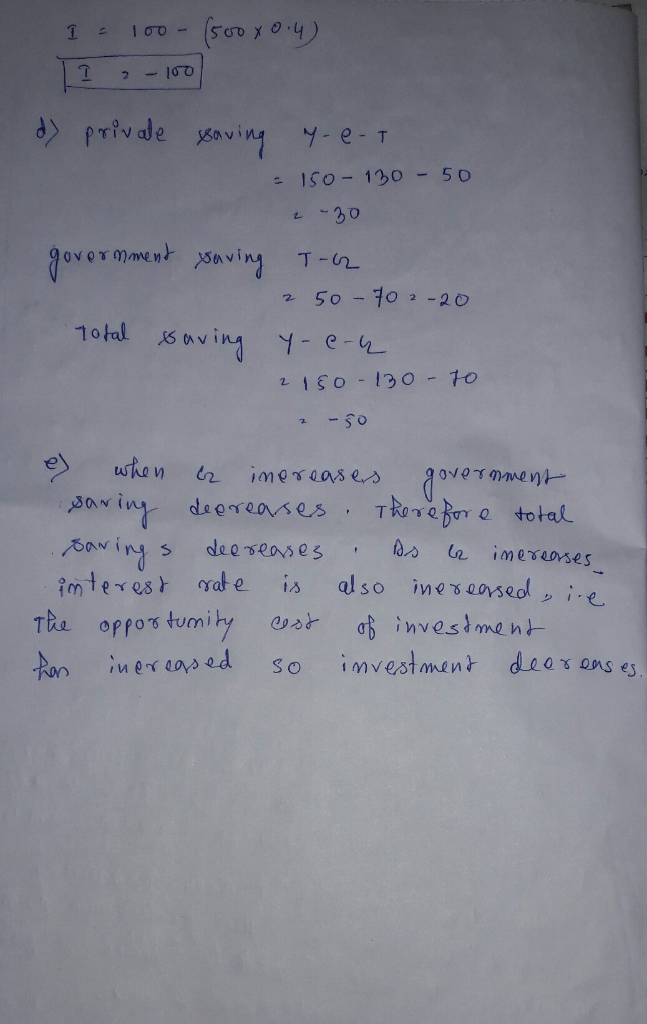Question
In: Economics
Assume that GDP is Y = 150. Consumption is C = 50 + .8(Y-T), Investment is...
- Assume that GDP is Y = 150. Consumption is C = 50 + .8(Y-T),
Investment is I = 100 – 500r, where r is the real interest rate.
Taxes are T = 50 and government expenditures are G =20.
- Calculate the equilibrium values of C, I, and r.
- Calculate the equilibrium values of private saving, government saving, and total saving.
- Now suppose due to a war there is an increase in Government expenditures to G=70 without a corresponding increase in taxes (aka it is funded by deficit spending). Calculate C, I, and r.
- Calculate the new equilibrium values of private saving, government saving, and total saving.
- What happened as a result of the deficit funded ↑ in G? Think of which values have actually changed, was this discussed in class previously?
Solutions
Related Solutions
2. C = 50 + .8YD = 50 + .8(Y – T) I = 150...
2. C = 50 + .8YD = 50 + .8(Y – T)
I = 150
G = 200
T = 200
a) Calculate ∆Y if ∆G = 100 (assuming that G could
change all by itself).
b) Calculate ∆Y if ∆T = 100 (assuming that T could change all by
itself).
c) Calculate ∆Y for ∆G = ∆T = 100. Show that you could have
predicted this result from your answers to parts a and b.
A. Assume that GDP (Y) is 6,000B. Consumption (C) is given by the equation C =...
A. Assume that GDP (Y) is 6,000B. Consumption
(C) is given by the equation C = 600B + 0.8(Y – T). Investment (I)
is given by the equation I = 2,000B – 100B(r), where r is the real
rate of interest. Taxes (T) are 500B and government spending (G) is
also 500B. Show/type your work/calculations!
1. In this economy, compute private savings, public savings, and
national savings (6 points)
Private savings =
Public savings =
National savings...
(15pt) Assume that GDP (Y) is 5,000. Consumption (C) is given by the equation C =...
(15pt) Assume that GDP (Y) is 5,000. Consumption (C) is given by
the equation C = 1,200 +
0.3(Y – T) – 50r, where r is the real interest rate, in percent.
Investment (I) is given by the
equation I = 1,500 – 50r. Taxes (T) are 1,000, and government
spending (G) is 1,500. Here,
notice that C is negatively related to the real interest
rate.
a)What are the equilibrium values of C, I, and r? (3pt)
b)What are the...
Assume that GDP (Y) is 10,000. Consumption (C) is given by the equation C = 500...
Assume that GDP (Y) is 10,000. Consumption (C) is given by the
equation C = 500 + 0.8(Y – T). Investment (I) is given by the
equation I = 2,000 – 50r, where r is the real rate of interest in
percent. Taxes (T) are 500 and government spending (G) is also 500.
a. What are the equilibrium values of C, I, and r? (Show your work)
(4.5 marks) b. What are the values of private saving, public
saving, and...
Assume that GDP (Y ) is 5,000 in a closed economy. Consumption (C) is given by...
Assume that GDP (Y ) is 5,000 in a
closed economy. Consumption (C) is given by the equation C =
1,200+0.3(Y −T)−50r, where r is the real interest rate, in percent.
Investment (I) is given by the equation I = 1, 500 − 50r. Taxes (T
) are 1,000, and government spending (G) is 1,500.
(a) What are the equilibrium values of
C, I, and r?
(b) What are the values of private
saving, public saving, and national saving? (...
In the Keynesian cross model, assume that the consumption function is given by C=$70+0.7(Y−T)C=$70+0.7(Y−T) Planned investment...
In the Keynesian cross model, assume that the consumption
function is given by C=$70+0.7(Y−T)C=$70+0.7(Y−T) Planned
investment is $200; government purchases and taxes are both
$100.
What level of government purchases is needed to achieve an
income of $1160? Assume taxes remain at $100.
What level of taxes is needed to achieve an income of $1160?
Assume government purchases remain at $100.
1. GDP (Y) = C + I + G Consumption = 10 + .75Y Investment =...
1. GDP (Y) = C + I + G
Consumption = 10 + .75Y
Investment = 20 + .15Y
Government = 35
The size of the expenditure multiplier for this
hypothetical economy is
a. 4.
b. 10.
c. 2.
d. none of the other answers are correct.
2. Find the level of equilibrium income, given the
following values for the economy:
Consumption = 10 + .75Y
Investment = 20 + .15Y
Autonomous Taxes = 20
Government = 30
a. 180...
In the Keynesian cross model, assume that the consumption function is given by C=$105+0.7(Y−T) Planned investment...
In the Keynesian cross model, assume that the consumption
function is given by C=$105+0.7(Y−T) Planned investment is $150;
government purchases and taxes are both $150.
c. If government purchases increase to $165,
what is the new equilibrium income? What is the multiplier for
government purchases?
new Y = $
multiplier:
1. Assume that the consumption function is given by C = 200 + 0.5(Y – T)...
1. Assume that the consumption
function is given by C = 200 + 0.5(Y –
T) and the investment function is I = 1,000 –
200r, where r is measured in percent, G
equals 300, and T equals 200.
What is the numerical formula for the
IS curve? What is the slope of the IS curve?
(Hint: The slope of the IS curve is the
coefficient of Y when the IS curve is written
expressing r as a function of...
1. Assume that the consumption function is given by C = 200 + 0.5(Y – T)...
1. Assume that the consumption
function is given by C = 200 + 0.5(Y –
T) and the investment function is I = 1,000 –
200r, where r is measured in percent, G
equals 300, and T equals 200.
a. What is the
numerical formula for the IS curve?
b. What is the slope
of the IS curve? (Hint: The slope of the
IS curve is the coefficient of Y when the
IS curve is written expressing r as a...
ADVERTISEMENT
ADVERTISEMENT
Latest Questions
- 1) Two vectors, r and s lie in the x y plane. Their magnitudes are 4.84 and...
- What artifacts, espoused values, enacted values and norms, and assumptions demonstrate the culture of Southwest Airlines?
- 1) 10000 lb/h of a 40.00% NaoH solution is crystallized through a combined evaporator-crystallizer process. The...
- STRICT DOWNVOTE IF NOT DONE FULLY, WILL REPORT ALSO IF COPY PASTED OR MODIFIED ANSWER Develop...
- The three questions are basically looking for an observation, asking the question and then giving the...
- YOU are the financial officer at an Austrian company that wants to BUY USD 1.000.000 of...
- Please read the whole program (all the way to the bottom), Thanks in advance! Develop car...
ADVERTISEMENT


 Rahul Sunny answered 2 months ago
Rahul Sunny answered 2 months ago